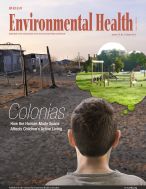Children’s perspectives on fighting obesity in one of the poorest counties in the U.S.

 Imagine streets lined with litter, speeding cars, unleashed dogs and dark streets after sunset. These are the neighborhoods of the Texas-Mexico Border Colonias where childhood obesity among Mexican-American children is rampant. It is no wonder these children seldom desire to participate in physical activities that other children in safer, cleaner environments enjoy each day.
Imagine streets lined with litter, speeding cars, unleashed dogs and dark streets after sunset. These are the neighborhoods of the Texas-Mexico Border Colonias where childhood obesity among Mexican-American children is rampant. It is no wonder these children seldom desire to participate in physical activities that other children in safer, cleaner environments enjoy each day.
“Mexican-American children are disproportionately affected by obesity compared to other population groups,” says lead researcher Nelda Mier, formerly of the Texas A&M Health Science Center School of Rural Public Health. In seeking answers, Mier and additional researchers went right to the heart of the matter – conducting focus groups with colonia children ages 8 to 13.
“Mexican-American Children’s Perspectives: Neighborhood Characteristics and Physical Activity in Texas-Mexico Border Colonias,” discusses the complex issues from the children’s point of view and is the cover article of this month’s Journal of Environmental Health. This study is one of the first to examine physical activity environmental factors in one of the most social and economically disadvantaged areas of the U.S.
The study found that children wanted PE classes in school to include outdoor activities like trampoline jumping and playing hide-and-seek rather than requiring push-ups, sit-ups, etc. Children not only indicated that physical characteristics of their neighborhood hindered their ability to be active, but social factors such as not having parents and friends involved in their exercise activities were also contributing factors.
“These findings are important for informing key decision makers about ways to promote physical activity among the underserved,” stresses Regents and Distinguished Professor Marcia Ory, Ph.D. of the Texas A&M School of Rural Public Health and a co-researcher on the project. “Policy recommendations promoting physical activity should address neighborhood safety, physical activity supportive infrastructure, regulations restricting unleashed dogs, and strict traffic regulations.” Ory also emphasizes it is important that “urban development include sidewalks, green areas, street connectivity, zoning, and mixed-land use.”
The study was funded by the Robert Wood Johnson Foundation (RWJF) Salud America program.
Additional authors include: Chanam Lee, Ph.D. and Laura Trevino, M.E., Texas A&M College of Architecture; Marcia Ory, Ph.D. and David Irizarry, Texas A&M School of Rural Public Health; Matthew Smith, Ph.D., University of Georgia; Xiaohui Wang, Ph.D., University of Texas Pan American; and Elias Avila-Rodriguez, Ph.D., Universidad Juarez del Estado de Durango.
Learn more about poverty and hunger in the border colonias in this video from the Washington Post.
Media contact: media@tamu.edu


